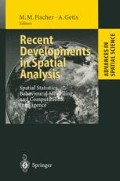Abstract
This paper considers issues associated with the construction of regions as part of a programme of exploratory spatial data analysis in the case of what Cressie (1991) refers to as “lattice data”. Lattice data arise where a study area has been partitioned into a set of zones or regions attached to each of which is a vector that describes the set of attributes for that zone. The focus of this paper will be the analysis of health data so the attributes in question may be health related but may also include demographic, socio-economic and environmental attributes.
Access this chapter
Tax calculation will be finalised at checkout
Purchases are for personal use only
Preview
Unable to display preview. Download preview PDF.
References
Anderberg M.R. 1973. Cluster analysis for applications. Academic Press. New York Anselin L. 1995. Local indicators of spatial association–LISA. Geographical Analysis, 27: 93–115.
Barkley D.L., Henry M.S.. Bao S. and Brooks K.R. 1995. How functional are economic areas? Tests for intra-regional spatial association using spatial data analysis. Papers in Regional Science 74: 297–316.
Bithell J.F. 1990. An application of density estimation to geographical epidemiology. Statistics in Medicine 9: 691–701.
Clayton D. and Kaldor J. 1987. Empirical Bayes estimates of age-standardized relative risks for use in disease mapping. Biometrics 43: 671–681.
Cliff, Haggett, Ord, Bassett and Davies. 1975. Elements of spatial structure. Cambridge University Press.
Cliff A.D. and Ord J.K. 1981. Spatial processes: models and applications. Pion, London.
Cressie N. 1984. Towards resistant geostatistics. In G.Verly, et al (eds) Geo-statistics for natural resources characterization. 21–44. Reidel, Dordrecht.
Cressie N.A.C. 1991. Statistics for spatial analysis. John Wiley and Sons, New York.
Elliott P.. Cuzick J., English D. and Stem R. 1992. Geographical and environmental epidemiology: methods for small area studies. Oxford University Press.
Fotheringham A.S. and Wong D.W.S. 1991. The modifiable areal unit problem in multivariate statistical analysis. Environment and Planning A, 23: 1025–1044.
Gatrell A.C. 1989. On the spatial representation and accuracy of address-based data in the United Kingdom. International Journal of Geographical Information Systems 3: 335–48.
Getis A. and Ord J.K. 1992. The analysis of spatial association by use of distance statistics. Geographical Analysis 24: 75–95.
Haining R.P., Wise S.M. and Blake M. 1994. Constructing regions for small area analysis: material deprivation and colorectal cancer. Journal of Public Health Medicine 16: 429438.
Haining R.P, Wise S.M. and Ma J. 1996. The design of a software system for interactive spatial statistical analysis linked to a GIS. Computational Statistics (in press).
Haining R.P. 1996. Spatial statistics and the analysis of health data. Paper presented to the GISDATA workshop on GIS and health. Helsinki, June 1996.
Haslett J., Wills G. and Unwin A.R. 1990. SPIDER–an interactive statistical tool for the analysis of spatially distributed data. International Journal of Geographical Information Systems 4: 285–296.
Haslett J., Bradley R., Craig P.S.,Wills G. and Unwin A.R. 1991. Dynamic graphics for exploring spatial data with application to locating global and local anomalies. American Statistician, 45: 234–42.
Horn M.E.T. 1995. Solution techniques for large regional partitioning problems. Geographical Analysis 27: 230–248.
Lankford P.M. 1969. Regionalisation: Theory and Alternative Algorithms. Geographical Analysis 1: 196–212.
McQueen J. 1967. Some Methods for Classification and Analysis of Multivariate Observations. Proceedings of the 5th Berkeley Symposium on Mathematical Statistics and Probability, 1: 281–297.
Oliver M.A. and Webster R. 1989. A geostatistical basis for spatial weighting in multivariate classification. Mathematical Geology 21: 15–35.
Openshaw S. 1978. An optimal zoning approach to the study of spatially aggregated data. in Masser I. and Brown P.J. (eds) Spatial Representation and Spatial Interaction. Martinus Nijhoff,Leiden, 95–113.
Openshaw S. 1984. The modifiable areal unit problem. Concepts and Techniques in Modern Geography 38. GeoAbstracts, Norwich.
Openshaw S. and Rao L. 1994. Re-engineering 1991 census geography: serial and parallel algorithms for unconstrained zone design.
Ord J.K. and Getis A. 1995. Local spatial autocorrelation statistics: distributional issues and an application. Geographical Analysis 27: 286–306.
Raper J., Rhind D.W and Shepherd J.W. 1990. Postcodes: the new geography. Longman, Harlow.
Rosenfeld A. and Kak A. 1982. Digital picture processing. Academic Press. London.
Sammons R. 1978. A simplistic approach to the redistricting problem. in Masser I. and Brown P.J. (eds) Spatial Reprsentation and Spatial Interaction. Martinus Nijhoff. Leiden71–94.
Semple R.K. and Green M.B. 1984. Classification in Human Geography. in G.L.Gaile and C.J.Wilmott (eds) Spatial statistics and models, Reidel, Dordrecht, 55–79.
Spath H. 1980. Cluster Analysis Algorithms. John Wiley and Sons, New York.
Taylor P.J. 1969. The location variable in taxonomy. Geographical Analysis 1: 181–195.
Author information
Authors and Affiliations
Editor information
Editors and Affiliations
Rights and permissions
Copyright information
© 1997 Springer-Verlag Berlin Heidelberg
About this chapter
Cite this chapter
Wise, S., Haining, R., Ma, J. (1997). Regionalisation Tools for the Exploratory Spatial Analysis of Health Data. In: Fischer, M.M., Getis, A. (eds) Recent Developments in Spatial Analysis. Advances in Spatial Science. Springer, Berlin, Heidelberg. https://doi.org/10.1007/978-3-662-03499-6_5
Download citation
DOI: https://doi.org/10.1007/978-3-662-03499-6_5
Publisher Name: Springer, Berlin, Heidelberg
Print ISBN: 978-3-642-08321-1
Online ISBN: 978-3-662-03499-6
eBook Packages: Springer Book Archive

